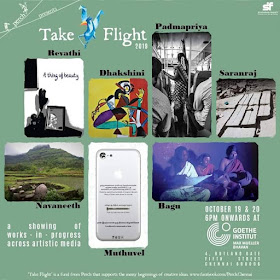Coming from the illustrious family that she does, soaked in the arts of dance and music, every move, word and gesture of Mahathi Kannan is bound to be watched with intent interest and expectations. It's a joy to watch her perform outshining these expectations and carrying them effortlessly and responsibly on her slender shoulders.
It is a huge responsibility being called out to revive a legend's classic work. Mahathi made a delicious cake of it and served it with finesse in presenting Krishnaya Tubhyam Namaha, a piece, her legendary grand aunt Padma Subramanyam premiered in the 1970s. The piece came alive in all its splendor in young Mahathi's presentation, giving us a glimpse of what an exquisite piece it would have been in young Padma's presentation and giving it a touch of her charm and sensibility.
The production is a riveting one in itself in the huge gamut it covers of Krishna's life from his birth through his growing up and segments portraying his various virtues; and in the eclectic choice of songs to portray the segments.
It struck a beautiful chord at various levels and with the flavor margazhi to start with ' oruthi maganaai piranthu' and more so with Mahathi's hair dressed in the Aandal Kondai. The performance proceeded thereafter with segments featuring Krishna's progression in a lullaby, Kaalinga narthanam, Lover of Rukmini, Krishna the Friend, and finally Krishna the Gita purusha.
Mahathi made her mark early in the performance and set the high standard in the Lullaby piece. She dished out a wide range of emotions and expressions completely at ease. Be it the loving gesture to put the child to sleep, the growing anxiety, that slowly turns to restlessness that tires you out, and finally, just as you think the child has dozed off, the desperate helplessness when some stray noise wakes the child up. She brought to stage all these travails that every mother undergoes, with so much grace and elan. Just as you were thinking that a great piece was coming to an end, a surprising turn brings so much joy and colour to close the piece.
The swaying movements in Kaalinga narthanam, evoke the features of signature interventions/ interpretations of Padma Subramanyam. The 'Achyutha' piece that followed was a joy unparalleled. The piece was about Rukmini struggling to write a letter to her beloved Krishna summoning him to carry her away and save her from a forced marriage. Rukmini's struggles to pen a letter was reminiscent of many such scenes portrayed in films, evoking a timeless romantic appeal. It was a pinnacle of a moment when Gayathri Kannan's vocal brilliance and Mahathi's cute bhavam came together and created a beautiful sequence to be treasured forever. This sequence forms the central piece of this production and should appeal to sensibilities across all strands of rasikas.
The segment glorifying Krishna as the friend saw Mahathi toggling with ease and proficiency of acting skills between the humble and overwhelmed Sudhama and the gracious Krishna.
KTN in Mahathi's rendition will be etched as a milestone in the dance annals of the sabha era for gloriously doing justice to a legend's creation and giving it a new lease of life of it's own. Mahathi as PS' protege has proved to be a roaring success without any trace of doubt, this was also evident in her short presentation i got to witness at Navadisha 2019. However i look forward to seeing her breaking out of her gurukul mould create a distinct personage of her own. That's going to be another himalayan task ahead of the young shoulders of Mahathi.
The swaying movements in Kaalinga narthanam, evoke the features of signature interventions/ interpretations of Padma Subramanyam. The 'Achyutha' piece that followed was a joy unparalleled. The piece was about Rukmini struggling to write a letter to her beloved Krishna summoning him to carry her away and save her from a forced marriage. Rukmini's struggles to pen a letter was reminiscent of many such scenes portrayed in films, evoking a timeless romantic appeal. It was a pinnacle of a moment when Gayathri Kannan's vocal brilliance and Mahathi's cute bhavam came together and created a beautiful sequence to be treasured forever. This sequence forms the central piece of this production and should appeal to sensibilities across all strands of rasikas.
The segment glorifying Krishna as the friend saw Mahathi toggling with ease and proficiency of acting skills between the humble and overwhelmed Sudhama and the gracious Krishna.
KTN in Mahathi's rendition will be etched as a milestone in the dance annals of the sabha era for gloriously doing justice to a legend's creation and giving it a new lease of life of it's own. Mahathi as PS' protege has proved to be a roaring success without any trace of doubt, this was also evident in her short presentation i got to witness at Navadisha 2019. However i look forward to seeing her breaking out of her gurukul mould create a distinct personage of her own. That's going to be another himalayan task ahead of the young shoulders of Mahathi.































